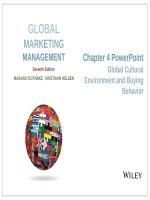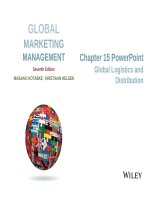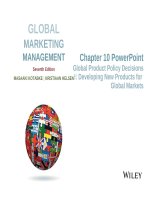Lecture Global marketing management (7th edition): Chapter 15 - Masaaki Kotabe, Kristiaan Helsen
Bạn đang xem bản rút gọn của tài liệu. Xem và tải ngay bản đầy đủ của tài liệu tại đây (3.24 MB, 30 trang )
GLOBAL
MARKETING
MANAGEMENT
Seventh Edition
MASAAKI KOTABKE | KRISTIAAN HELSEN
Chapter 15 PowerPoint
Global Logistics and
Distribution
Chapter Overview
1.
2.
3.
4.
5.
6.
Definition of Global Logistics
Managing Physical Distribution
Managing Sourcing Strategy
Free Trade Zones
International Distribution Channel
International Retailing
Chapter 15
Copyright © 2017 John Wiley & Sons,
Inc.
2
Introduction
• Global logistics and distribution have played a
critical role in the growth and development of world
trade and in the integration of business operations
on a worldwide scale.
• The use of appropriate distribution channels in
international markets increases the chances of
success dramatically.
• In the United States, the total logistics cost stayed
around 10 percent of the GDP from 2006 to 2008,
but has moderately declined to 8.3 percent GDP in
2014.
Chapter 15
Copyright © 2017 John Wiley & Sons,
Inc.
3
Introduction
• As firms start operating on a global basis, logistics
managers need to manage shipping of raw
materials, components, and supplies among various
manufacturing sites at the most economical and
reliable rates.
• The development of intermodal transportation and
electronic tracking technology has resulted in a
quantum jump in the efficiency of the logistic
methods employed by firms worldwide.
Chapter 15
Copyright © 2017 John Wiley & Sons,
Inc.
4
1. Definition of Global Logistics
• Global logistics is defined as the design and
management of a system that directs and controls
the flows of materials into, through, and out of the
firm across national boundaries to achieve its
corporate objectives at a minimum total cost (Exhibit
15-1).
Chapter 15
Copyright © 2017 John Wiley & Sons,
Inc.
5
Exhibit 15-1
Chapter 15
Copyright © 2017 John Wiley & Sons,
Inc.
6
1. Definition of Global Logistics
Materials management refers to the inflow of raw
materials, parts, and supplies in and through the
firm.
Physical distribution refers to the movement of
the firm’s finished products to its customers,
consisting of transportation, warehousing,
inventory, customer service/order entry, and
administration.
Sourcing strategy refers to an operational link
between materials management and physical
distribution and deals with how companies
managed R&D (e.g., product development and
engineering), operations
manufacturing),
Copyright © 2017 John(e.g.,
Wiley & Sons,
Chapter 15
7
Inc.
and marketing activities.
2. Managing Physical Distribution
• The following factors contribute to the increased
complexity and cost of global logistics:
–
–
–
–
–
Distance
Exchange rate fluctuation
Foreign intermediaries
Regulation
Security
Chapter 15
Copyright © 2017 John Wiley & Sons,
Inc.
8
2. Managing Physical Distribution
• Modes of Transportation—Important Factors
– Value-to Volume Ratio
– Perishability
– Cost of Transportation
• Modes of Transportation—Methods
– Ocean Shipping
• Liner Service
• Bulk Shipping
– Airfreight
– Intermodal Transportation
Chapter 15
Copyright © 2017 John Wiley & Sons,
Inc.
9
2. Managing Physical Distribution
• Warehousing and Inventory Management
– Hedging against Inflation and Exchange Rate
Fluctuations
– Benefiting from Tax Differences
– Logistical Integration and Rationalization
– E-Commerce and Logistics
Chapter 15
Copyright © 2017 John Wiley & Sons,
Inc.
10
2. Managing Physical Distribution
• Third-Party Logistics (3PL) Management
– The largest 3PL sector is the value-added
warehousing and distribution industry.
• Logistical Revolution with the Internet
– The trend toward third-party logistics is a result of the
Internet and the intranet as well as concentrating on
core competencies.
Chapter 15
Copyright © 2017 John Wiley & Sons,
Inc.
11
3. Managing Sourcing Strategy
Companies adopt international sourcing for the
following reasons:
• Intense international competition
• Pressure to reduce costs
• The need for manufacturing flexibility
• Shorter product-development cycles
• Stringent quality standards
• Continually changing product and process
technology
• Improvement in information technology
Copyright © 2017 John Wiley & Sons,
• 15Reduction in investment
in fixed assets
Chapter
Inc.
12
3. Managing Sourcing Strategy
• Procurement: Types of Sourcing Strategy (Exhibit
15-2)
– Insourcing (or In-House Sourcing)
• Domestic
• Offshore
– Outsourcing (or Contract Manufacturing)
• Domestic
• Offshore
• Outsourcing of Service Activities
– Intellectual outsourcing and software
– Core and supplementary services
Chapter 15
Copyright © 2017 John Wiley & Sons,
Inc.
13
Exhibit 15-2
Chapter 15
Copyright © 2017 John Wiley & Sons,
Inc.
14
Exhibit 15-3: Major Reasons for
Outsourcing
Chapter 15
Copyright © 2017 John Wiley & Sons,
Inc.
15
4. Free Trade Zones
• A free trade zone (FTZ) is an area that is located
within a nation (say, the United States), but is
considered outside of the customs territory of the
nation.
• U.S. FTZs are licensed by the Foreign Trade Zone
Board and operated under the supervision of the US
Customs Service. Presently, some 500 FTZs are in
operation. Across the U.S., about 420,000 jobs are
directly related to activity in FTZs.
Chapter 15
Copyright © 2017 John Wiley & Sons,
Inc.
16
4. Free Trade Zones
• FTZs provide many cash flow and operating
benefits to zone users (Exhibit 15-5):
1. Duty deferral and elimination
2. Lower tariff rates
3. Lower tariff incidence
4. Exchange rate hedging
5. Import quota not applicable
6. “MADE IN U.S.A.” designation
Chapter 15
Copyright © 2017 John Wiley & Sons,
Inc.
17
Exhibit 15-5: Benefits of Using a Foreign
Trade Zone (FTZ) in the United States
Chapter 15
Copyright © 2017 John Wiley & Sons,
Inc.
18
5. International Distribution Channel
• Firms may reach their customers through:
– Their own local salesforce
– The internet
– Independent intermediaries, most often at the local
level
Chapter 15
Copyright © 2017 John Wiley & Sons,
Inc.
19
Exhibit 15-6: International Distribution
Channel Alternatives
Chapter 15
Copyright © 2017 John Wiley & Sons,
Inc.
20
5. International Distribution Channel
• Guidelines for selecting foreign intermediaries:
– Search for intermediaries capable of developing
markets, not just those with good contacts
– Regard intermediaries as long-term partners
– Actively search for and select intermediaries, not the
other way around
– Support your intermediaries by committing resources
Continued
Chapter 15
Copyright © 2017 John Wiley & Sons,
Inc.
21
5. International Distribution Channel
Continued
–Ensure intermediaries provide information you need,
including market and sales performance data
–Attempt to control marketing strategy as much as
possible
–Make links with national intermediaries as soon as
possible after entering a foreign market
Chapter 15
Copyright © 2017 John Wiley & Sons,
Inc.
22
6. International Retailing
• In developed countries, retailing employs between 7
and 12 percent of the workforce.
• Retailing involves very locally entrenched activities,
including stocking an assortment of products that
local consumers prefer, catering to local shopping
patterns, and seasonal promotion as well as
meeting local competition on a daily basis.
Adaptation is a key success factor.
Chapter 15
Copyright © 2017 John Wiley & Sons,
Inc.
23
6. International Retailing
• In 2013, Wal-Mart was the largest retailer in the
world with a total revenues of over $476 billion. Only
10 percent of its sales are generated outside its core
NAFTA region, compared with Carrefour’s 20
percent of sales generated outside its core Europe
region.
• In general, European retailers tend to be more
willing to customize their marketing and
procurement strategies to various local market
peculiarities than U.S. or Japanese retailers.
Chapter 15
Copyright © 2017 John Wiley & Sons,
Inc.
24
Exhibit 15-7: International Operations of
the World’s Top 10 Retailers
Chapter 15
Copyright © 2017 John Wiley & Sons,
Inc.
25









